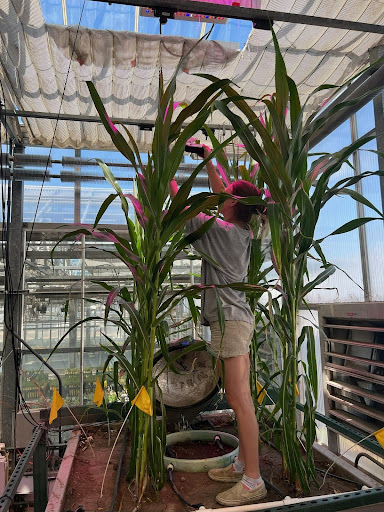
UIPA’s Emissions Inventory Analyst explains why baseline emissions inventories are crucial to clean air efforts
Michelle Bohnen working as a research assistant for the Biometeorology Group in the Department of Soil, Water, and Climate at the University of Minnesota-Twin Cities. She is growing corn for an experimental setup to study agricultural greenhouse gas emissions.
Michelle Bohnen, the CPP’s Emissions Inventory Analyst, has been working on emissions inventories for the last four years. In this Q&A, she explains the role of the baseline emissions inventory in the Clean Ports Program, as well as why measuring baselines is so important for creating successful clean air programs.
What is a baseline emissions inventory?
A baseline emissions inventory is a record of emissions from a snapshot in time at a particular location. An inventory can measure any kind of substance, whether gas or particle, that is released into the air and that could potentially impact people or the environment. Depending on the context, this might include particulate matter (such as dust), greenhouse gases, nitrogen oxides, ozone, and other kinds of chemicals.
Why do we measure baseline emissions?
As emissions change over time at a given location, the baseline gives us something to compare these changes to. For instance, baseline inventories are often done to establish a starting point before beginning an emissions reduction effort, so that progress can be measured. Emissions inventories can also help entities set realistic, measurable goals for improving air quality – or tailor clean air programs to particular locations.
When can you use a baseline emissions inventory?
Baseline emissions inventories can be helpful in a lot of different contexts, from agriculture to transportation to supply chains. For example, during my Master’s degree research I developed an agricultural emissions inventory to help understand how crop field emissions are affected by the type and amount of fertilizer used.
What will the Clean Ports Program baseline emissions inventory look at?
This inventory will look at the Salt Lake City Intermodal Terminal (SLCIT), a facility owned by Union Pacific where cargo is moved between train and truck. The terminal is located south of I-80, in Salt Lake City’s Northwest Quadrant. We will include emissions from drayage trucks, cargo-handling equipment, locomotives, and other non-road equipment servicing the terminal.
For the Clean Ports inventory, what kinds of data will you consider?
We are still finalizing the exact kinds of data we will use for this inventory. But we could potentially look at information such as the make, model, vehicle year, engine, and fuel type of the equipment used at the terminal. These kinds of data enable us to estimate the amount and type of emissions produced by different kinds of equipment. We can combine this data with information about the operation hours of different types of equipment to assess total annual emissions.
Tell us about this grant’s quality assurance processes. How do you make sure the data and analysis is as accurate as possible?
The grant’s quality assurance and control processes are outlined in the Quality Assurance Project Plan (QAPP), a document that the EPA requires from Clean Ports Program grantees. Quality assurance starts with developing clear standards for what data is acceptable to use, as well as how to evaluate the quality of data and data sources based on metrics such as accuracy, comprehensiveness, and representativeness. The QAPP also details how we will document, organize, and track our data, reports, and analysis to ensure transparency. Additionally, it builds in opportunities for reviews and assessments of our data sources, analysis methods, and final products–not only by trained EPA and project staff, but also by independent third parties.
How will this inventory be used? How might it be helpful?
This inventory will help us evaluate the success of upcoming emissions reduction efforts, especially those led by the Utah Division of Air Quality’s Zero-Emission Technology Deployment Program, our partner Clean Ports grant, which will provide funding to acquire electric vehicles and equipment at the SLCIT. Along with the baseline emissions inventory, we will be developing a combination of five varying, unique Reference Case Scenarios that will be analyzed for potential emissions reductions. Each one represents a specific possible future scenario where emissions have been reduced by electrifying different percentages of the SLCIT’s diesel vehicles and equipment (0%, 25%, 50%, 75%, and 100%). For each scenario, we will estimate emissions reductions, cost, and local air quality benefits, which will enable comparison of scenarios. Comparing these scenarios will help decision-makers identify the emissions reduction strategies that provide the greatest potential for air quality improvement. These scenarios will also enable us to quantify the emissions reductions achieved through upcoming Clean Ports Program electrification efforts and track our progress over time.
Have more questions about the Baseline Emissions Inventory, UIPA’s Quality Assurance Project Plan, or anything else related to data collection and analysis for this project? Reach out to Michelle Bohnen directly at [email protected].
